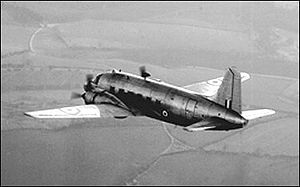Vickers Valetta
| Valetta | |
|---|---|
 |
|
| Role | Military transport aircraft |
| Manufacturer | Vickers-Armstrongs Ltd |
| First flight | 30 June 1947 |
| Number built | 262 |
| Developed from | Vickers VC.1 Viking |
| Variants | Vickers Varsity |
The Vickers Valetta was a British twin-engine military transport aircraft of the late 1940s. It was an all-metal mid-wing monoplane with a tailwheel undercarriage.
The Valetta was a military transport development of the Viking civil airliner. The 58th Viking (c/n 158) became the prototype Valetta, which was first flown from Brooklands by test pilot Mutt Summers on 30 June 1947. The Valetta differed from the Viking fundamentally in being fitted with more powerful engines, a strengthened floor and large loading doors.
The Viking and Valetta provided the basis of the Varsity. The Varsity although similar was slightly larger and had a tricycle landing gear and under-fuselage pannier.
The Valetta C.1 entered service with the RAF in 1948, replacing the Douglas Dakota with RAF Transport Command and with transport squadrons in the Middle and Far East. The Valetta was used to carry out parachute drops in the 1956 Suez Crisis, and was used to provide transport support for a number of other British Military operations in the 1950s and 1960s, such as during the Malayan Emergency and operations in Aden.
The Valetta C.2 was a VIP passenger transport and extra range.
The Valetta T.3 was built to provide a navigational trainer for service with the RAF College at RAF Cranwell and with No.1 and No.2 Air Navigation Schools. 40 were delivered from August 1951, with the last being WJ487 in September 1952.
18 Valetta T.3 aircraft were later converted to T.4 standard with a longer nose to fitted to accommodate a radar scanner in order to train crews in the AI (Airborne Interception) role.
Data from Vickers Aircraft since 1908.
General characteristics
Performance
...
Wikipedia
